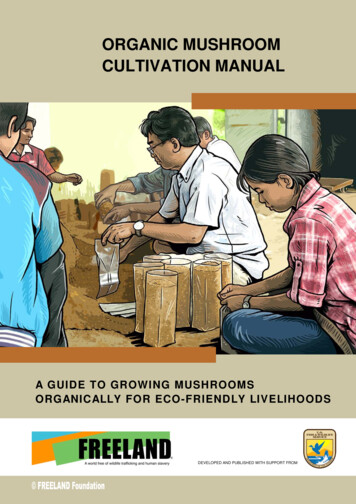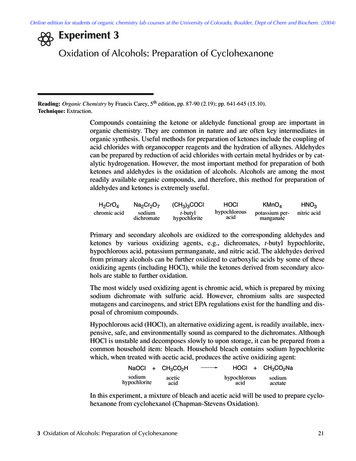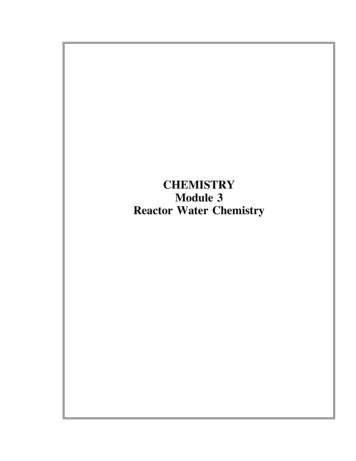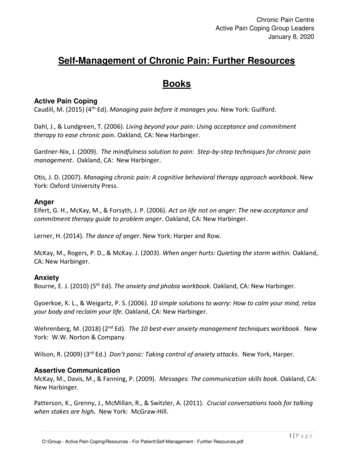
Transcription
UNIT 11 – FURTHER ORGANIC CHEMISTRYUNIT 11FURTHER ORGANIC CHEMISTRYStudent f)(g)Alcohols (alkanols)Carboxylic acids (alkanoic acids) and AlkanoatesAmines and Amino AcidsAddition and Condensation PolymersIntroduction to BiochemistrySoaps and Soapless DetergentsSeparating, Purifying and Identifying Organic CompoundsKey words: alkanol (alcohol), fermentation, hydration, distillation, distillate, primary alcohol, secondary alcohol,tertiary alcohol, alkanoic acid (carboxylic acid), alkanoate (carboxylate), ester, alkoxide, condensation, hydrolysis,amine, amino acid, peptide, polymer, monomer, co-polymer, plastic, thermoplastic, thermosetting plastic, resin,polyester, polyamide, fat, oil, triglyceride, fatty acid, glycerol, hydrogenation, carbohydrate, monosaccharide,disaccharide, polysaccharide, protein, Fehling’s solution, Benedict’s solution, Biuret solution, soap, saponification,soapless detergent, hydrophilic, hydrophobic, recrystallisation, chromatographyUnits which must be completed before this unit can be attempted:Unit 1 – Atomic Structure and the Periodic TableUnit 2 – Particles, Structure and BondingUnit 3 – Amount of SubstanceUnit 4 – Introduction to Physical ChemistryUnit 5 – Acids, Bases and SaltsUnit 6 – Redox ReactionsUnit 7 – Introduction to Organic ChemistryUnit 8 – Solubility and Precipitation ReactionsUnit 9 – Metals and their CompoundsEstimated Teaching Time: 14 hours1
UNIT 11 – FURTHER ORGANIC CHEMISTRYUNIT 11 SUMMARY AND SYLLABUS REFERENCELesson Title and Syllabus Reference1Structure and Physical Properties of AlcoholsCA11i.i alkanols – structure; CA11i.ii alkanols – physical properties (including those due to intermolecularhydrogen bonding); ISA13 organic and inorganic compounds (alkanols (methanol, ethanol, propanol) functional groups, properties and uses of organic compounds)2Preparation of EthanolCA11i.i alkanols- sources (laboratory preparation including hydration of alkenes, industrial and localproduction of ethanol including alcoholic beverages, harmful impurities and methods of purification shouldbe mentioned), ISA13 organic and inorganic compounds (alkanols (methanol, ethanol) - functional groups,properties and uses of organic compounds)3Chemical Properties of Alcohols ICA11i.ii alkanols - classification (primary, secondary and tertiary alkanols); CA11i.iv alkanols – chemicalproperties (reaction with Na, conc. H2SO4, I2/NaOH); ISA13 organic and inorganic compounds (alkanols(methanol, ethanol, propanol), alkanoic acids – first two members - functional groups, properties and uses oforganic compounds)4Chemical Properties of Alcohols II – OxidationCA11i.iv alkanols – chemical properties (oxidation by KMnO4, K2Cr2O7, I2/NaOH); CA11ji alkanoic acids –sources; ISA13 organic and inorganic compounds (alkanols (methanol, ethanol) - functional groups,properties and uses of organic compounds)5Carboxylic Acids and Alkanoate SaltsCA11aii nomenclature and functional groups (systematic nomenclature of alkanoic acids and alkanoates(salts)); CA11ji alkanoic acids - sources, nomenclature and structure; CA11jii alkanoic acids - physicalproperties (including those due to intermolecular hydrogen bonding); CA11jiii alkanoic acids - chemicalproperties (acid properties only: i.e. reactions with H2O, NaOH, NaHCO3), CA11jiv alkanoic acids - laboratorytest (reaction with NaHCO3); CA11jv alkanoic acids - uses and properties (uses and properties of ethanoicand phenylmethanoic (benzoic) acids as examples of aliphatic and aromatic acids respectively) CA13cvcharacteristic test tube reactions of the functional group in alkanoic acids; CC6h alkanoic acids (recognitionof mono and dioic acids); ISA4.3 ionic and covalent compounds (IUPAC names of common compounds);ISA13 organic and inorganic compounds (alkanols (methanol, ethanol, propanol), alkanoic acids (first twomembers) - functional groups, properties and uses of organic compounds); ISA13.2 neutralization (equationsrepresenting neutralization reactions)6Esters – Preparation and ReactionsCA11aii nomenclature - functional groups (systematic nomenclature of alkanoates (esters)) CA11i.ivalkanols - chemical properties (reaction with alkanoic acids (esterification)); CA11i.v alkanols - laboratorytest, CA11ki alkanoates - sources, nomenclature and structure (preparation of alkyl alkanoates (esters) fromalkanoic acids); CA11kii alkanoates - physical properties; CA11kiii alkanoates - chemical properties(hydrolysis of esters (mechanism not required)); CA13cv characteristic test tube reactions of the functionalgroups in the following simple organic compounds: alkenes, alkanols, alkanoic acids; ISA4.3 ionic andcovalent compounds (IUPAC names of common compounds); ISA13 organic and inorganic compounds(alkanols (methanol, ethanol, propanol), alkanoic acids (first two members), alkanoates (first two members) functional groups, properties and uses of organic compounds); ISA13.2 neutralization and esterification(differences between neutralization and esterification, equations representing esterification reactions)7Qualitative Analysis - Identification of Organic Functional GroupsCA11i.v alkanols - laboratory test; CA13cv characteristic test tube reactions of the functional groups in thefollowing simple organic compounds: alkenes, alkanols, alkanoic acids2
UNIT 11 – FURTHER ORGANIC CHEMISTRYLesson Title and Syllabus Reference8Amines and Amino AcidsCA11aii nomenclature - functional groups (systematic nomenclature of amines); CA11m amino acids(difunctional nature of amino acids); ISA4.3 ionic and covalent compounds (IUPAC names of commoncompounds)9Addition Polymers and PlasticsCA11ni natural and synthetic polymers – definitions (polymerisation, addition and condensation polymers,plastics and resins, thermoplastic and thermosetting polymers); CA11nii important properties of polymers;CA11niv synthetic polymers (classification and preparation based on the monomers and co-polymers);ISA13.3 petrochemicals (uses of petrochemicals such as plastics)10Condensation PolymersCA11ni natural and synthetic polymers – definitions (polymerisation, condensation polymers); CA11niiimportant properties of polymers; CA11niv synthetic polymers (classification and preparation based on themonomers and co-polymers); CC6g alkanols (recognition of the structures of mono- and diols); CC6h alkanoicacids (recognition of mono and dioic acids)11Biochemistry: Lipids and CarbohydratesCA11l fats and oils: sources, physical and chemical properties (alkanoates (esters), hardening of oils);CA11niii natural polymers - carbohydrates: formulae, properties and uses (classification asmonosaccharides, disaccharides and polysaccharides, reducing and non-reducing sugars using glucose,fructose, sucrose/maltose and starch/cellulose as examples, hydrolysis of sucrose and starch); CA13cvcharacteristic test tube reactions of the functional groups in sugars (using Fehling’s and Benedict’ssolutions only) and starch (iodine test only); ISA13 organic and inorganic compounds (fats and oils functional groups, properties and uses)12Biochemistry: Proteins; Food TestsCA11niii natural polymers - proteins (as polymers of amino acid molecules linked by peptide or amidelinkage, hydrolysis, uses in living systems); CA13cv characteristic test tube reactions of the functionalgroups in sugars (using Fehling’s and Benedict’s solutions only), starch (iodine test only) and proteins(using the Ninhydrin test, Xanthoproteic test, Biuret test and Millon’s test only)13Soaps and Soapless DetergentsCA11l fats and oils: sources, physical and chemical properties (saponification, detergents as soaplessdetergents, comparison of soapless detergents with soapy detergents and their action on soft water and hardwater); ISA13 organic and inorganic compounds (fats and oils - functional groups, properties and uses)14Separation, Purification and Analysis of Organic CompoundsCA4aiii chemical equations (calculations involving formulae and equations will be required); CA11bseparation and purification (methods to be discussed should include: distillation, crystallisation, drying,chromatography); CA11c determination of empirical and molecular formulae and molecular structures oforganic compounds; CA13aiii General Skills and Principles – Recrystallisation15Unit 11 Revision and Summary3
UNIT 11 – FURTHER ORGANIC CHEMISTRY4
UNIT 11 – FURTHER ORGANIC CHEMISTRYLesson 1 – What are alcohols?a) Alcohols (alkanols)(i)Physical Properties of AlcoholsSummary Activity 1.1: What are alcohols?Name, and draw the structures of, the first three members of the homologous series of alcoholsDraw and name one branched aliphatic alcohol and one alicyclic alcoholWhat is hydrogen bonding? Why can alcohols form hydrogen bonds?What properties of alcohols are likely to result from their ability to form hydrogen bonds?How many alcoholic drinks can you think of? How are they made?Are there any other uses of alcohols that you are aware of? Alcohols (also known as alkanols) are saturated molecules containing an –OH group; examples of simplealcohols are methanol and ethanol Aliphatic alcohols have the general formula CnH2nO The H atom in the O-H bond can form hydrogen bonds with other alcohol molecules and with water:Hydrogen bond between a water molecule and anethanol molecule:--Hydrogen bond between two ethanol xchange.comAs a result of hydrogen bonding between alcohol molecules, alcohols have stronger intermolecular forcesbetween them, and hence higher boiling points, than other molecules of similar size (eg the boiling point ofmethanol, which contains 18 electrons, is 65 oC, but the boiling point of ethane, which also contains 18electrons, is -89 oC)As a result of hydrogen bonding between alcohol and water molecules, many alcohols mix well with water As you ascend the homologous series of alcohols, the number of electrons in the molecule increases, so the Vander Waal’s forces between the molecules get stronger than the boiling point increases (eg the boiling point ofmethanol is 65 oC but the boiling point of ethanol is 78 oC) As you ascend the homologous series of alcohols, the length of the hydrocarbon section of the molecule (thealkyl group) increases; this part of the molecule cannot form hydrogen bonds and it limits the ability of thealcohol to form hydrogen bonds with water; the longer the chain, the more it disrupts the hydrogen bonds withwater molecules and the lower the solubility of the alcohol (eg ethanol is highly soluble in water but hexan-1-olis only sparingly soluble)5
UNIT 11 – FURTHER ORGANIC CHEMISTRY Because alcohols have a non-polar hydrocarbon chain as well as an -OH group, they often mix readily with nonpolar substances as well; this means that many alcohols can mix well with both water and non-polar substances;as a result, alcohols (especially ethanol) make very good solvents Alcohols are toxic; most humans, however, have the ability to break ethanol down; as a result most humans cantolerate moderate quantities of ethanol; even small quantities, however, affect the nervous system and cancause both physical and mental impairment (being drunk); ethanol is widely used in alcoholic drinks; thehuman body is not able to break down any of the other alcohols and as a result these alcohols are consideredmore highly toxic Some alcohols contain more than one -OH group; these are known as diols (if they have two -OH groups) orpolyols (if they have many -OH groups); they are very important in biochemistry and industry- two important examples are:NameStructureUsesethan-1,2-diolAdded to water to lower thefreezing point and preventfreezing; it is also known asantifreezepropan-1,2,3-triolAlso known as glycerol; this isproduced by breaking down fatsand can be used as a source ofenergy-diols and polyols have high water solubility due to the large number of OH groups which can form hydrogenbonds with waterTest your knowledge 1.2: Explaining the physical properties and uses of alcohols(a) Explain why ethanol has a higher boiling point than butane(b) Explain why ethanol is soluble in water but butane is not(c) Explain why ethanol has a lower boiling point than butan-1-ol(d) Explain why ethanol is more soluble in water than butan-1-ol(e) State two uses of ethanolLesson 2 – How is ethanol made?(ii)-Preparation of AlcoholsSummary Activity 2.1: Distillation and fractional distillationWhat is fractional distillation used for and how does it work?What types of substances are best separated by fractional distillation?6
UNIT 11 – FURTHER ORGANIC CHEMISTRY Much of the ethanol in the world is produced by decomposing glucose in a process called fermentation:C6H12O6 2C2H5OH 2CO2Successful fermentation requires- the presence of yeast, which acts as a catalyst for the reaction- a temperature of 35 – 55 oC- the absence of air Fermentation has several advantages of other methods of producing ethanol:- it is a low-technology process, which means it can be used anywhere- it does not use much energy- it uses sugar cane or other fruit/vegetables as a raw material, which is a renewable resource- the other ingredients in the raw materials can give make drinks with pleasant tastes There are also some disadvantages associated with the fermentation process:- it is a batch process, which means that once the reaction has finished the vessel needs to be emptied beforethe reaction can be started again- it is a relatively slow process- it does not produce pure ethanol Throughout the world, alcoholic drinks are produced on a large scale (industrially) and on a small scale (locally)by fermentation; there are two main risks associated with locally-brewed alcohol:- methanol is a very toxic substance produced in small quantities during fermentation; in low-concentrationalcohols such as beer or wine, it is not present in harmful levels; in spirits, however, methanol levels can bedangerous if care is not taken to remove the methanol b
Unit 7 – Introduction to Organic Chemistry Unit 8 – Solubility and Precipitation Reactions Unit 9 – Metals and their Compounds Estimated Teaching Time: 14 hours . UNIT 11 – FURTHER ORGANIC CHEMISTRY 2 UNIT 11 SUMMARY AND SYLLABUS REFERENCE Lesson Title and Syllabus Reference 1 Structure and Physical Properties of Alcohols CA11i.i alkanols – structure; CA11i.ii











